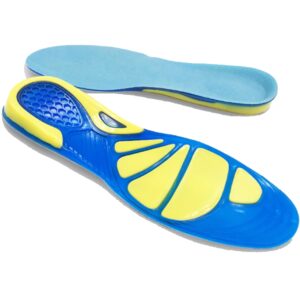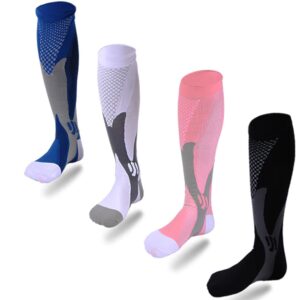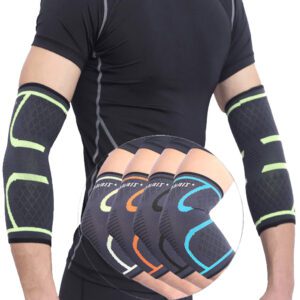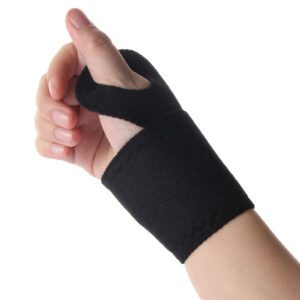Bone spurs are small bony growths on the surface of bones that develop when there is joint damage or arthritis. They can be painful, but they should not cause any long-term health problems. Bone spurs are sometimes called osteophytes. The areas of the body that are mostly affected are the feet, hands, knees and spine. This article focuses on the feet as it’s a part of the “foot pain series“. Here’s what you need to know about them.
What are bone spurs / heel spurs?
Bone spurs that occur on the human foot are heel spurs in most cases. This is because they usually develop on the heel bone (calcaneus). Sometimes, however, bone spurs can form on other bones of the foot or even in your hand or spine. Bone spurs are not tumors but are actually an overgrowth of bone tissue that will cause pain when they press on a nerve or the joint itself. Bone spurs tend to develop in people of 60 years and older more often, but anybody can get them. People diagnosed with osteoarthritis are at much larger risk of getting bone spurs.
What does a bone spur look like?
Bone spurs typically have a hook shape, with a pointy end pointing towards the bones of the foot. They are usually found at the point where a tendon or ligament attaches to the bone. Depending on which bone they appear on, you may see one or multiple spurs protruding from your foot. Bone spurs can also be seen on an X-ray image of the foot.
Are bone spurs in foot painful?
As stated above, bone spurs are actually quite painful. A lot of people have no idea they even have bone spurs until they start to hurt due to the fact that there is very little pain in the beginning stages. Bone spurs can cause a great deal of pain when walking or moving the foot.
Symptoms
While some people don’t even know of having bone spurs, symptoms may get wore over time. If you have bone spurs on your foot, chances are that you will experience some pain. You may notice it in the front of the foot where the toes attach to the rest of the foot or at the heel. Bone spurs can cause a lot of pain and discomfort when walking, during which you may begin to limp.
In most cases, you can feel some knobby or bumpy areas on your feet. Your range of motion may be affected because the joint cannot move as far as it should anymore. This can even cause stiffness in the joint. Nearby tendons can get swelling, which is called tendinitis.
Are bone spurs serious?
In many cases bone spurs and, in this case, heel spurs can go undetected for several years. That is because in the vera beginning, bone spurs basically cause no symptoms at all. However, the underlying reason could be osteoarthritis, and that can be a serious condition.
Bone spurs are often not even treated and can get better on their own in most cases. Patients need to do some specific exercises and just need to rest for a few days to weeks, depending on the severeness of the pain. But in most cases, bone spurs are not that serious.
Is walking good for heel spurs?
As long as you don’t walk too much and you rest the area that hurts, walking is good for bone spurs. The pressure can actually help with the pain and promote healing in some cases. However, make sure not to overdo it because walking could make the condition worse if done improperly.
How long do heel spurs last?
Bone spurs don’t go away on their own. If you want to get rid of the, you’ll need to have surgery to remove them.
Causes
The biggest cause of bone spurs is OA – Osteoarthritis. OA is a disease where there is a loss of cartilage in the joints. When this flexible tissue that cushions the bone is missing, this causes bones to rub against each other, leading to pain and bone spurs can develop much easier. OA is often the result of a sports injury, but develops as we age as well. That’s why elderly suffer from bone spurs way more than younger people.
When cartilage is damaged, the body tries to repair it. It creates new bone material. And these bony growths are osteophytes, bone spurs.
So, in general, we can say that bone spurs is the reaction of your body to heal itself.
Besides other medical conditions, there are some more factors that can increase the risk of getting heel spurs. If you engages in physical activities regularly, especially running or jogging, chances are that you can damage your heel and heel spurs may be the consequence. Running on hard surfaces definitely favors the development of heel spurs.
Walking abnormalities that put excessive weight and stress on the heel bone, the ligaments and nerves are another cause. Wearing shoes that don’t provide proper support for the arch or that are not fitting well can make this condition even worse.
Diagnosis
We learned that bone spurs may not show any symptoms. So how do you know that you have one? In many cases, bone spurs are discovered accidentally during an X-ray or other tests for other conditions.
How do you know if you have a bone spur in your foot?
The first thing you need to do is visit a doctor. They will do a physical exam and ask you questions about your medical history, including any pain or discomfort in the affected area.
Your doctor may ask you to describe your symptoms and will probably test your joint’s range of motion and strength. If you mention pain, stiffness or loss of motion, your healthcare provider or doctor will order X-ray images to look for arthritis and spurs. CT scans or MRIs can identify damaged ligaments or tendons as the root of evil too.
Do bone spurs show up on X-rays?
Yes, bone spurs are bony bumps that can be seen on X-ray images.
What is the difference between heel spurs and plantar fasciitis?
Bone spurs and plantar fasciitis usually cause pain in the heel or arch of your foot. However, they are very different conditions. A bone spur is a bony growth that projects from the heel bone on both feet and can be either small or large. They appear when your body tries to heal itself after some damage such as an injury, or after an inflammatory condition like arthritis.
Plantar fasciitis is a pain in the heel that occurs on one foot. The fibers of the plantar fascia are irritated which causes inflammation and swelling. The arch of the foot will hurt most when you take your first step in the morning or if you stop suddenly during walking.
And while being different, one can cause the other condition. Heel spurs can cause inflammation of the plantar fascia which is called plantar fasciitis.
Treatment
If you don’t have any symptoms associated with bone spurs, you don’t need any treatment. In cases where you experience pain, you need to change your lifestyle a bit if you don’t want surgical treatment. More than 90 percent of people get better with non-surgical treatment. Your doctor may recommend orthotic devices or insoles to support your arch and reduce the pressure on your heel. They will also suggest exercises and certain medicines that can help with the pain.
Conservative treatments are:
- stretching exercises
- applying ice packs
- getting new shoes
- taping stressed muscles and tendons
- shoe inserts, insoles or orthotic devices
- night splints
- compression socks
- physical therapy
- over-the-counter medications such as ibuprofen
Again, in the vast majority of all cases, conservative treatment options work really well. But if those treatments fail after a period of 6-12 months, surgery may be necessary to relieve the pain.
How do you get rid of bone spurs in your feet?
Bone spurs or heel spurs won’t just go away. And while you can try to fight them with conservative treatment, surgery is the only way to completely get rid of them.
In most cases, it is a minimally invasive procedure called “nonsurgical excision” where the doctor will cut off the bony projections so they won’t cause any issues in the future. There are no incisions or stitches required for this procedure. You can get back to your daily routine the same day or after a few days.
The real success of this surgery comes in when you combine it with non-surgical treatments (orthotics, stretching exercises) which will work with the body and help avoid any foot pain in the future.
The second surgical technique is the release of the plantar fascia. It is also known as “plantar fasciotomy”. It involves cutting or releasing the tight band of tissue that runs under your foot.
Your doctor will discuss with you whether one or the other is better for your individual situation.
Can Apple cider vinegar dissolve bone spurs?
There are a lot of myths about how you can naturally heal bone spurs, heel spurs or plantar fasciitis. Apple cider vinegar is not likely to dissolve heel spurs. This kind of vinegar has many benefits, though it’s also quite acidic, so be careful with the amount you use or where you apply it.
Depending on the condition and severity of your bone spur, you may need more than just apple cider vinegar for relief from pain associated with this condition. But it definitely won’t hurt to try it out, as there are no side effects of apple cider vinegar and it is widely available.
Can bone spurs be removed without surgery?
A nonsurgical approach to removing bony projections is often seen as the first treatment choice because it has little risk of complications. Besides physical therapy you can try radiofrequency ablation, chiropractic therapies and acupuncture. Radiofrequency ablation is the use of electric currents to heat up a needle that is used to “burn” your nerves and prevent pain signals that way.
The symptoms caused by bone spurs may be associated with the misalignment of your foot. Your podiatrist or chiropractor can adjust this for you, which may reduce the amount of pain you feel.
Acupuncture may be another thing to try. Especially when used in combination with traditional Chinese medicine, you have good chances of relieving some pain caused by the symptoms of osteoarthritis or bone spurs. Putting tiny needles into your nerves and muscles releases the body’s natural endorphins. And these natural pain killers can really work wonders.
What happens if heel spurs are left untreated?
If you don’t get any treatment for your heel spurs, they will probably get worse. The pain you feel might get more severe and the bones may break or fracture. If this happens, it’s likely that bone fragments will get into your joint or damage tissue near your heel. This can be very serious condition and you certainly want to avoid this.
Small tears in the fascia (sometimes known as “micro-injuries”) can develop over time if plantar fasciitis is not treated. You may not be aware of the precise moment that each little tear forms, although your pain level will gradually increase. If these tears are left untreated, they may grow in size and number, making the plantar fascia more and more vulnerable to rupture.
Plantar fasciitis can lead to plantar rupture if it is not treated, and an individual continues to engage in activities that put a lot of strain on the plantar fascia. Jogging, sports, or even standing for lengthy periods of time in ill-fitting shoes might all cause this kind of injury.
Products that help with heel spurs
Most products that are designed to help with heel spurs are made to keep your feet comfortable. They are basically insoles or shoe inserts that have extra cushioning in the right places. This is especially helpful if you need to spend long periods of time on your feet because it protects the plantar fascia from further damage, and can even reduce pain after prolonged use.
You can also choose to wear shoes that are made in a way that they do not cause extra pressure on the plantar fascia in your feet. This is why some people who suffer from plantar fasciitis opt for more flat-soled, wider shoes. Others may prefer to go for wide toe box shoes that have a low heel. In any case, it is very important that you choose shoes that are comfortable and fit well, as this will help prevent your condition from getting worse.
Compression sleeves or compression socks are another option you can go for. Designed to be worn at all times, these will promote good blood flow and help prevent swelling and other symptoms commonly associated with heel spurs.
Night splints, boots or casts are other options that can be mentioned. For example, rigid night splints are worn at night and keep the plantar fascia stretched (which is helpful for heel spurs) while you sleep. They are typically used in combination with physical therapy.
For appropriate products that will help you ease your pain and start the healing process, please make sure to visit our shop.
Bone spurs can be problematic if left untreated. They may cause pain in the joints and lead to other serious conditions such as plantar fasciitis or bone fractures. To avoid these problems, it is important that you speak with a podiatrist about the symptoms of your condition and how they might affect your foot. You should also consult with an acupuncturist who specializes in treating osteoarthritis-this will help alleviate some of the discomfort caused by this painful disorder while promoting healing at the same time! If you need assistance finding products for heel spurs, please visit our store where we have wide range of insoles and shoe inserts that are perfect for helping relieve inflammation from excessive pressure on your feet.
Comment below and share your thoughts. Have you ever had heel spurs or have you experienced something similar? How did you fix the problem?



















